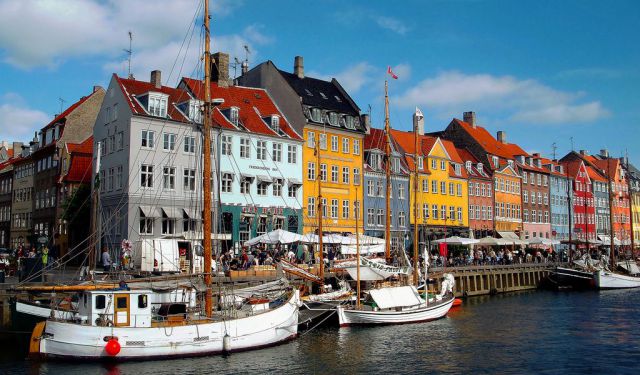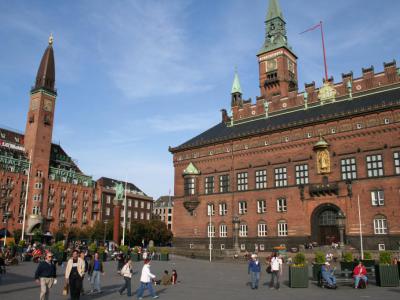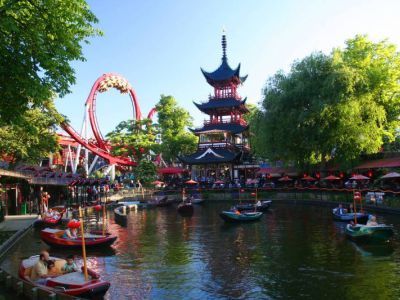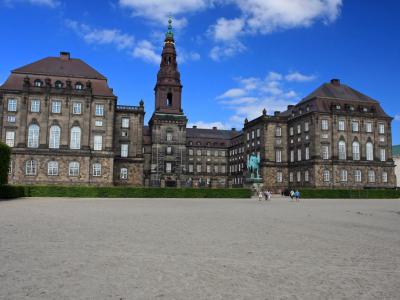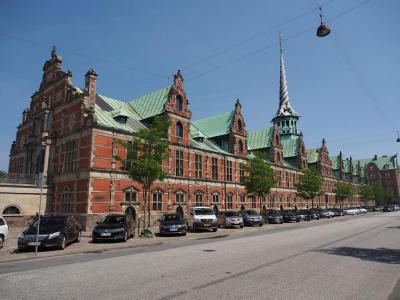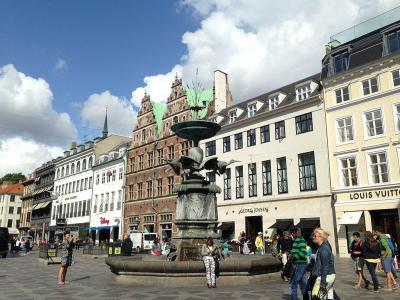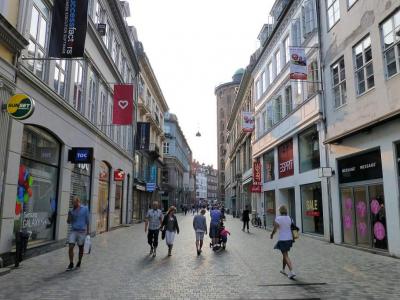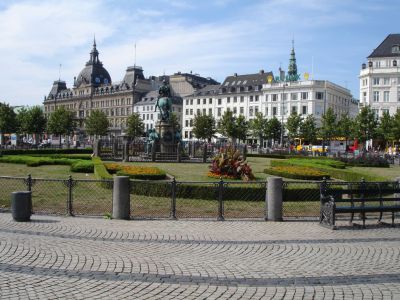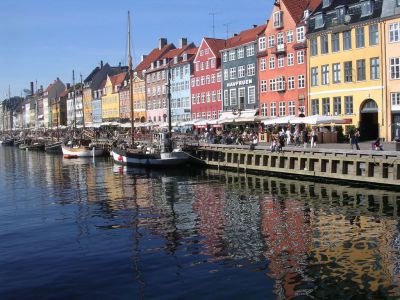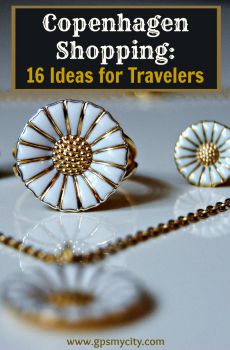Audio Guide: Copenhagen Introduction Walking Tour (Self Guided), Copenhagen
The Danish capital Copenhagen is a fairy tale of a city, full of peculiarities. Its name – derived from the Danish words for merchant ("køpmann") and harbor ("havn") – reflects the city's origin as a place of commerce by the sea. A humble fishing village, established in the 10th century AD, some hundred years later it emerged as a town after Bishop Absalon, recognized as the city's founder, built a modest fortress on the island of Slotsholmen.
Copenhagen flourished as the cultural and economic center of Scandinavia for well over 200 years. In the early 15th century it became the capital of Denmark and by the 17th century consolidated its position as a regional center of power. Throughout the Renaissance, Copenhagen served as a de facto capital of the Kalmar Union, governing the majority of the present-day Nordic region.
After an outbreak of plague and fire in the 18th century, the city underwent a period of redevelopment that included, among other projects, the construction of the regal Christiansborg Palace. The early 19th century saw the Danish Golden Age which brought a Neoclassical look to Copenhagen's architecture. After the Second World War, the so-called “Finger Plan” fostered the city's modern urban and cultural evolution that carries on well into the 21st century.
Often referred to as "the City of Spires", Copenhagen is indeed well-known for its horizontal skyline broken by spires. One such tops the City Hall – the seat of Copenhagen's municipal council that rises majestically over the City Hall Square.
The historical core of Copenhagen, the Inner City, is a labyrinth of cobblestone streets and colorful buildings, each echoing stories of the past. Among them is the New Harbor canal lined with colorful houses from the 17th and 18th centuries, as well as Stroget, one of the longest pedestrian thoroughfares in Europe. Other important local landmarks include the enchanting Tivoli Gardens, one of the world's oldest amusement parks.
Art and history enthusiasts will find solace in the New Carlsberg art museum, established by the son of the Carlsberg Breweries founder. Nearby, the National Museum of Denmark further complements this cultural journey, showcasing an array of artifacts narrating the richness of Danish and global history.
Copenhagen invites you to walk its streets, explore its museums, and immerse yourself in its gardens. For a charming urban experience and a more detailed acquaintance with the notable sights of the Danish capital, embark on this self-guided introductory voyage.
Copenhagen flourished as the cultural and economic center of Scandinavia for well over 200 years. In the early 15th century it became the capital of Denmark and by the 17th century consolidated its position as a regional center of power. Throughout the Renaissance, Copenhagen served as a de facto capital of the Kalmar Union, governing the majority of the present-day Nordic region.
After an outbreak of plague and fire in the 18th century, the city underwent a period of redevelopment that included, among other projects, the construction of the regal Christiansborg Palace. The early 19th century saw the Danish Golden Age which brought a Neoclassical look to Copenhagen's architecture. After the Second World War, the so-called “Finger Plan” fostered the city's modern urban and cultural evolution that carries on well into the 21st century.
Often referred to as "the City of Spires", Copenhagen is indeed well-known for its horizontal skyline broken by spires. One such tops the City Hall – the seat of Copenhagen's municipal council that rises majestically over the City Hall Square.
The historical core of Copenhagen, the Inner City, is a labyrinth of cobblestone streets and colorful buildings, each echoing stories of the past. Among them is the New Harbor canal lined with colorful houses from the 17th and 18th centuries, as well as Stroget, one of the longest pedestrian thoroughfares in Europe. Other important local landmarks include the enchanting Tivoli Gardens, one of the world's oldest amusement parks.
Art and history enthusiasts will find solace in the New Carlsberg art museum, established by the son of the Carlsberg Breweries founder. Nearby, the National Museum of Denmark further complements this cultural journey, showcasing an array of artifacts narrating the richness of Danish and global history.
Copenhagen invites you to walk its streets, explore its museums, and immerse yourself in its gardens. For a charming urban experience and a more detailed acquaintance with the notable sights of the Danish capital, embark on this self-guided introductory voyage.
How it works: Download the app "GPSmyCity: Walks in 1K+ Cities" from Apple App Store or Google Play Store to your mobile phone or tablet. The app turns your mobile device into a personal tour guide and its built-in GPS navigation functions guide you from one tour stop to next. The app works offline, so no data plan is needed when traveling abroad.
Copenhagen Introduction Walking Tour Map
Guide Name: Copenhagen Introduction Walking Tour
Guide Location: Denmark » Copenhagen (See other walking tours in Copenhagen)
Guide Type: Self-guided Walking Tour (Sightseeing)
# of Attractions: 11
Tour Duration: 2 Hour(s)
Travel Distance: 2.7 Km or 1.7 Miles
Author: DanaOffice
Sight(s) Featured in This Guide:
Guide Location: Denmark » Copenhagen (See other walking tours in Copenhagen)
Guide Type: Self-guided Walking Tour (Sightseeing)
# of Attractions: 11
Tour Duration: 2 Hour(s)
Travel Distance: 2.7 Km or 1.7 Miles
Author: DanaOffice
Sight(s) Featured in This Guide:
- City Hall (Radhus)
- City Hall Square (Radhuspladsen)
- Tivoli Gardens
- Ny Carlsberg Glyptotek – Art Museum
- National Museum of Denmark (Nationalmuseet)
- Christiansborg Palace
- Old Stock Exchange (Borsen)
- Stork Fountain
- Stroget Pedestrian Street
- King's New Square (Kongens Nytorv)
- New Harbor (Nyhavn)
1) City Hall (Radhus) (must see)
Copenhagen City Hall, designed by famous architect Martin Nyrop and inspired by Siena's Town Hall in Italy, stands prominently on City Hall Square. The hall was inaugurated in 1905, showcasing the pinnacle of national romanticism in Denmark.
The building is marked by a striking facade decorated in rich ornamental style, featuring among other elements the roof statues of polar bears symbolizing the giant Danish protectorate of Greenland. A golden statue of Bishop Absalon, the city's founder, presides over the central balcony, while the clock tower, reaching 105.6 meters, marks one of Copenhagen's tallest structures. The tower clock, a notable feature, chimes daily at noon and during New Year's Eve at midnight.
The City Hall's architectural complex comprises three aligned buildings connected by longitudinal structures. The hall is linked via tunnels to the nearby buildings, ensuring a blend of historical elegance and modern functionality.
The interior layout includes meeting rooms, a wedding hall, and a banquet hall used by the municipality. At its heart lies the Town Hall Garden, open to the public during summer months and accessible from Hans Christian Andersen Boulevard. The front entrance boasts a glass mosaic depicting Copenhagen's coat of arms, commemorating the city's historical privileges and the City Hall's inauguration.
Inside the building, looking down on the inner grand hall (which is open to the public) are the marble busts of four celebrated locals: fairy-tale writer Hans Christian Andersen, sculptor Bertel Thorvaldsen, physicist Niels Bohr, and the building's architect Martin Nyrop. Downstairs are the national archives dating back to the 1270s.
As you leave, check out the amazing World Clock (opposite the info desk), the supreme mechanical astronomical chronometer in terms of function and precision. Built between 1943 and 1955, its displays include lunar and solar eclipses, positions of the stellar bodies, and a perpetual calendar, in addition to the time across the world's time zones. The clock's fastest gear completes a revolution every ten seconds, while the slowest – every 25,753 years!
Tip:
The main hall is free to enter, whereas to go up the tower you'll have to pay a small fee.
They escort you in groups at 11 am / 12:30 pm and 2 pm on weekdays and noon on Saturdays. You can join a guided English tour at 1 pm (on weekdays) and 10 am (on Saturdays).
As the building is central, the views are great and the viewing platform is square and large.
The building is marked by a striking facade decorated in rich ornamental style, featuring among other elements the roof statues of polar bears symbolizing the giant Danish protectorate of Greenland. A golden statue of Bishop Absalon, the city's founder, presides over the central balcony, while the clock tower, reaching 105.6 meters, marks one of Copenhagen's tallest structures. The tower clock, a notable feature, chimes daily at noon and during New Year's Eve at midnight.
The City Hall's architectural complex comprises three aligned buildings connected by longitudinal structures. The hall is linked via tunnels to the nearby buildings, ensuring a blend of historical elegance and modern functionality.
The interior layout includes meeting rooms, a wedding hall, and a banquet hall used by the municipality. At its heart lies the Town Hall Garden, open to the public during summer months and accessible from Hans Christian Andersen Boulevard. The front entrance boasts a glass mosaic depicting Copenhagen's coat of arms, commemorating the city's historical privileges and the City Hall's inauguration.
Inside the building, looking down on the inner grand hall (which is open to the public) are the marble busts of four celebrated locals: fairy-tale writer Hans Christian Andersen, sculptor Bertel Thorvaldsen, physicist Niels Bohr, and the building's architect Martin Nyrop. Downstairs are the national archives dating back to the 1270s.
As you leave, check out the amazing World Clock (opposite the info desk), the supreme mechanical astronomical chronometer in terms of function and precision. Built between 1943 and 1955, its displays include lunar and solar eclipses, positions of the stellar bodies, and a perpetual calendar, in addition to the time across the world's time zones. The clock's fastest gear completes a revolution every ten seconds, while the slowest – every 25,753 years!
Tip:
The main hall is free to enter, whereas to go up the tower you'll have to pay a small fee.
They escort you in groups at 11 am / 12:30 pm and 2 pm on weekdays and noon on Saturdays. You can join a guided English tour at 1 pm (on weekdays) and 10 am (on Saturdays).
As the building is central, the views are great and the viewing platform is square and large.
2) City Hall Square (Radhuspladsen)
City Hall Square (Rådhuspladsen), situated in the heart of the Danish capital, fronts the striking Copenhagen City Hall. As a prime venue for a myriad of events taking place in the city, this is a favored gathering spot for street performers and international folk visiting the capital. The square is notably used as a reference point for measuring distances from Copenhagen much as for many miles of beautiful pedestrian streets within the city. Just as in so many other places throughout Denmark, English is spoken here widely and, surprisingly so, often of better quality than you would hear in many English-speaking destinations.
The square's historical relevance dates back to the times when it was a hay market and housed the Western Gate of the city's fortifications. Back then, the area was overcrowded (housing as many as 150,000 people), which quite naturally led to hygiene problems. So, eventually, the walls had to come down.
Following the removal of fortifications in the 1850s, the area transitioned into an exhibition space. The late 19th century brought further transformative changes with plans to construct a new city hall, thus turning the square into a significant urban space. Subsequent redesigns in 1996 and more recently, in 2010, with the introduction of a metro station, enhanced its utility and accessibility.
Today, the square hosts, among other attractions, significant buildings like Politiken's House, home to the national newspaper 'Politiken', and the rather peculiar Dansk Industri building containing a showroom for green technologies (the House of Green), plus a series of two-story flagship stores and restaurants on the adjacent Vesterbro Street. Also nearby is the Radisson Blu Royal Hotel, Copenhagen's only skyscraper, built in 1960 as the world's first design hotel that focuses on visual appearance such as architecture, interior decor, or aesthetics style.
Among the artistic highlights in the square are the Dragon Fountain, installed in 1904, depicting a mythical battle between a bull and a dragon, and the Weather Girl sculpture, perched atop the Richs Building, which provides a whimsical weather forecast. Other notable additions to the square's cultural landscape include the statue of Hans Christian Andersen, the most popular Danish writer, and the bronze depiction of Lur Blowers mounted atop a tall terracotta column. The latter was a gift to the city from the Carlsberg Foundation on the occasion of the centenary of its founder, Jacob Christian Jacobsen.
In addition to being a dynamic venue for public expression, the square is surrounded by multiple bars and nightclubs and serves as a central transportation hub, continuing its legacy as a pivotal city landmark.
The square's historical relevance dates back to the times when it was a hay market and housed the Western Gate of the city's fortifications. Back then, the area was overcrowded (housing as many as 150,000 people), which quite naturally led to hygiene problems. So, eventually, the walls had to come down.
Following the removal of fortifications in the 1850s, the area transitioned into an exhibition space. The late 19th century brought further transformative changes with plans to construct a new city hall, thus turning the square into a significant urban space. Subsequent redesigns in 1996 and more recently, in 2010, with the introduction of a metro station, enhanced its utility and accessibility.
Today, the square hosts, among other attractions, significant buildings like Politiken's House, home to the national newspaper 'Politiken', and the rather peculiar Dansk Industri building containing a showroom for green technologies (the House of Green), plus a series of two-story flagship stores and restaurants on the adjacent Vesterbro Street. Also nearby is the Radisson Blu Royal Hotel, Copenhagen's only skyscraper, built in 1960 as the world's first design hotel that focuses on visual appearance such as architecture, interior decor, or aesthetics style.
Among the artistic highlights in the square are the Dragon Fountain, installed in 1904, depicting a mythical battle between a bull and a dragon, and the Weather Girl sculpture, perched atop the Richs Building, which provides a whimsical weather forecast. Other notable additions to the square's cultural landscape include the statue of Hans Christian Andersen, the most popular Danish writer, and the bronze depiction of Lur Blowers mounted atop a tall terracotta column. The latter was a gift to the city from the Carlsberg Foundation on the occasion of the centenary of its founder, Jacob Christian Jacobsen.
In addition to being a dynamic venue for public expression, the square is surrounded by multiple bars and nightclubs and serves as a central transportation hub, continuing its legacy as a pivotal city landmark.
3) Tivoli Gardens (must see)
Conveniently located in central Copenhagen, very close to the train station (for those traveling into town), Tivoli Gardens is the original inspiration for Walt Disney World – and it shows. The lovingly tended grounds – a wonderland of rides, games, restaurants, marching bands, funny mirrors, and roulette wheels – are picturesque and equally friendly for both kids and adults.
Tivoli is actually the second oldest, still operational amusement park in the world; the oldest one is also in Denmark. The wooden "Mountain" Roller Coaster (Bjergbanen or Rutschebanen) was built in 1914; its operator actually controls the ride by braking, so that it does not gain too much speed while descending the hills! Another roller coaster, The Demon (Dæmonen), features an “Immelmann” vertical loop and a zero-gravity roll – all in one ride that lasts one minute and 46 seconds. Also of note is The Star Flyer swing ride, opened in 2006, offering panoramic views of the city from an 80-meter (260-foot) elevation.
Apart from these exciting rides and a few thrilling towers, Tivoli is a venue for performing arts, counting among the major cultural hubs in Copenhagen. So even if you are not interested in the rides, there is plenty of space just to walk around, admire the prodigious flowers and large fountains, catch a free concert, or try a wide range of different foods: Mexican, Asian, Japanese, Italian, French, Danish, or regular street food like sandwiches/burgers, etc.
Tickets are both "pay as you go" and "pay once for all", which is affordable for every budget and worth it just to see the Danes – both young and old – at play. In the summer months they have fireworks displays every Saturday at 11:45 pm and if you don't want to stay all day, just have your hand stamped so you can re-enter at a later time.
Why You Should Visit:
Supposedly, this was the template that inspired Walt Disney to create his theme parks!
Fun to walk around in even if you don't go on any rides – a lovely way to spend time with friends.
Tip:
Great to come a bit before sunset, so you can see the place both in daylight and illuminated in the evening.
You can also take your own food and drink in a bag (they don't check them), as it's rather expensive inside.
Tivoli is actually the second oldest, still operational amusement park in the world; the oldest one is also in Denmark. The wooden "Mountain" Roller Coaster (Bjergbanen or Rutschebanen) was built in 1914; its operator actually controls the ride by braking, so that it does not gain too much speed while descending the hills! Another roller coaster, The Demon (Dæmonen), features an “Immelmann” vertical loop and a zero-gravity roll – all in one ride that lasts one minute and 46 seconds. Also of note is The Star Flyer swing ride, opened in 2006, offering panoramic views of the city from an 80-meter (260-foot) elevation.
Apart from these exciting rides and a few thrilling towers, Tivoli is a venue for performing arts, counting among the major cultural hubs in Copenhagen. So even if you are not interested in the rides, there is plenty of space just to walk around, admire the prodigious flowers and large fountains, catch a free concert, or try a wide range of different foods: Mexican, Asian, Japanese, Italian, French, Danish, or regular street food like sandwiches/burgers, etc.
Tickets are both "pay as you go" and "pay once for all", which is affordable for every budget and worth it just to see the Danes – both young and old – at play. In the summer months they have fireworks displays every Saturday at 11:45 pm and if you don't want to stay all day, just have your hand stamped so you can re-enter at a later time.
Why You Should Visit:
Supposedly, this was the template that inspired Walt Disney to create his theme parks!
Fun to walk around in even if you don't go on any rides – a lovely way to spend time with friends.
Tip:
Great to come a bit before sunset, so you can see the place both in daylight and illuminated in the evening.
You can also take your own food and drink in a bag (they don't check them), as it's rather expensive inside.
4) Ny Carlsberg Glyptotek – Art Museum (must see)
The New Carlsberg Glyptotheque (Ny Carlsberg Glyptotek), commonly known simply as The Glyptotheque (Glyptoteket), is the sculpture museum that features the private art collection of Carl Jacobsen (1842–1914), the son of the founder of the Carlsberg Breweries.
The museum contains over 10,000 artworks spanning ancient Mediterranean cultures and modern European art, including the largest collection of Auguste Rodin's sculptures outside France. It also boasts numerous paintings by French Impressionists and Post-Impressionists (such as Monet, Manet, Degas, Cézanne, Van Gogh, Picasso, Renoir, Toulouse-Lautrec, etc.), as well as Danish Golden Age artists, complete with the extensive collections of Greek, Roman, Etruscan, and Egyptian antiquities.
Carl Jacobsen, a dedicated art collector, amassed a wealth of antique, French, and Danish sculptures during his life, which were initially displayed in his private villa's winter garden in 1882. As the collection outgrew its space, in 1888, Jacobsen donated all of it to the Danish State and the City of Copenhagen, contingent on them providing a suitable exhibition facility. A new location was chosen near Tivoli Gardens and opened on May 1, 1897.
Celebrated for its architectural elegance, the building harmoniously blends art with its structure. Featuring the historicist Dahlerup Wing with its Venetian Renaissance style and the neo-classical Kampmann Wing, it also includes a connecting Winter Garden and the minimalist Henning Larsen Wing, used for prestigious events.
What is more, the museum's wings are built around a very soothing, Victorian-style garden, rich with greenery and sculpture, under a translucent glass dome. If you can afford some extra time, it's always a nice place to relax for a while and enjoy coffee or lunch – especially in the winter, as you can be in nature and enjoy the warmth.
The Glyptotek Auditorium regularly hosts classical concerts featuring notable artists, as well as other cultural events including poetry readings and debates. Known for its excellent acoustics, the venue also accommodates rehearsals and performances by musical ensembles.
Why You Should Visit:
To enjoy a surprisingly good collection in a gorgeously modified setting (the open rooftop affords great views of the city!), plus the magnificent palm garden with many benches, ponds, a delicious café, and some horticultural wonders.
Tip:
Pick up a floor plan as you enter to help navigate the somewhat confusing layout. Take breaks to go through one wing at a time. You will need breaks, as the place is huge in an unexpected way.
Keep in mind that Tuesdays are free, so perhaps you could go multiple times to make sure you see it all.
The on-site classical music concerts are frequently free too, so try to catch one.
The museum contains over 10,000 artworks spanning ancient Mediterranean cultures and modern European art, including the largest collection of Auguste Rodin's sculptures outside France. It also boasts numerous paintings by French Impressionists and Post-Impressionists (such as Monet, Manet, Degas, Cézanne, Van Gogh, Picasso, Renoir, Toulouse-Lautrec, etc.), as well as Danish Golden Age artists, complete with the extensive collections of Greek, Roman, Etruscan, and Egyptian antiquities.
Carl Jacobsen, a dedicated art collector, amassed a wealth of antique, French, and Danish sculptures during his life, which were initially displayed in his private villa's winter garden in 1882. As the collection outgrew its space, in 1888, Jacobsen donated all of it to the Danish State and the City of Copenhagen, contingent on them providing a suitable exhibition facility. A new location was chosen near Tivoli Gardens and opened on May 1, 1897.
Celebrated for its architectural elegance, the building harmoniously blends art with its structure. Featuring the historicist Dahlerup Wing with its Venetian Renaissance style and the neo-classical Kampmann Wing, it also includes a connecting Winter Garden and the minimalist Henning Larsen Wing, used for prestigious events.
What is more, the museum's wings are built around a very soothing, Victorian-style garden, rich with greenery and sculpture, under a translucent glass dome. If you can afford some extra time, it's always a nice place to relax for a while and enjoy coffee or lunch – especially in the winter, as you can be in nature and enjoy the warmth.
The Glyptotek Auditorium regularly hosts classical concerts featuring notable artists, as well as other cultural events including poetry readings and debates. Known for its excellent acoustics, the venue also accommodates rehearsals and performances by musical ensembles.
Why You Should Visit:
To enjoy a surprisingly good collection in a gorgeously modified setting (the open rooftop affords great views of the city!), plus the magnificent palm garden with many benches, ponds, a delicious café, and some horticultural wonders.
Tip:
Pick up a floor plan as you enter to help navigate the somewhat confusing layout. Take breaks to go through one wing at a time. You will need breaks, as the place is huge in an unexpected way.
Keep in mind that Tuesdays are free, so perhaps you could go multiple times to make sure you see it all.
The on-site classical music concerts are frequently free too, so try to catch one.
5) National Museum of Denmark (Nationalmuseet) (must see)
The National Museum of Denmark (Nationalmuseet) is the largest institution dedicated to the country's cultural history. Its main building showcases a diverse range of exhibits spanning from Greenland to South America, emphasizing both Danish and international cultures.
Recounting 14,000 years of history, the museum presents a detailed narrative of Denmark's past from the Ice Age reindeer hunters to the Vikings, and further into the religiously influential Middle Ages. The museum explores the identity and evolution of the Danish people through various exhibits that detail daily life, national events, and the broader societal changes in Denmark from 1560 to 2000.
A prominent feature within the museum is The Greenland Research Center dedicated to archaeological and anthropological studies of the island. Also notable is the major Vikings exhibition, opened by Queen Margrethe II in 2013, which was featured internationally, including at the British Museum in London.
The museum's numismatic collection includes Danish coins from the Viking era to modern times, as well as ancient Roman and Greek coins, showcasing a broad perspective on historical currencies.
Additionally, the museum boasts a wealth of ancient artifacts from Greece, Italy, the Near East, and Egypt, highlighted by items from the 1957 Danish excavation of Tell Shemshara in Iraq.
Outside its core responsibilities, such as archaeology, ethnology, numismatics, ethnography, natural science, and conservation, the museum also plays a key role in managing the National Treasures (Danefæ) and overseeing antiquarian efforts related to Denmark's churches.
Tip:
After paying your entry fee, be sure to find out when a free one-hour tour of the museum's 'greatest hits' is available in your language.
Recounting 14,000 years of history, the museum presents a detailed narrative of Denmark's past from the Ice Age reindeer hunters to the Vikings, and further into the religiously influential Middle Ages. The museum explores the identity and evolution of the Danish people through various exhibits that detail daily life, national events, and the broader societal changes in Denmark from 1560 to 2000.
A prominent feature within the museum is The Greenland Research Center dedicated to archaeological and anthropological studies of the island. Also notable is the major Vikings exhibition, opened by Queen Margrethe II in 2013, which was featured internationally, including at the British Museum in London.
The museum's numismatic collection includes Danish coins from the Viking era to modern times, as well as ancient Roman and Greek coins, showcasing a broad perspective on historical currencies.
Additionally, the museum boasts a wealth of ancient artifacts from Greece, Italy, the Near East, and Egypt, highlighted by items from the 1957 Danish excavation of Tell Shemshara in Iraq.
Outside its core responsibilities, such as archaeology, ethnology, numismatics, ethnography, natural science, and conservation, the museum also plays a key role in managing the National Treasures (Danefæ) and overseeing antiquarian efforts related to Denmark's churches.
Tip:
After paying your entry fee, be sure to find out when a free one-hour tour of the museum's 'greatest hits' is available in your language.
6) Christiansborg Palace (must see)
Christiansborg Palace is where Danish democracy, royal pomp, and a bit of architectural resilience come together. This place isn’t just a palace but the unicorn of government buildings. It’s the only structure in the world that houses all three branches of government: the Parliament, the Prime Minister’s Office, and the Supreme Court. Talk about multitasking...
The current palace is the third on this site. The original castle built by the city's founder, Bishop Absalon, stood here since 1167. Its remains, along with those of its successor – Copenhagen Castle – have been excavated and are now visible in the subterranean section at Christiansborg. After suffering two major fires, in 1794 and 1884, the palace was rebuilt in a historicist Neo-baroque style by 1928.
Often called "the Castle of the Realm" or simply "the Castle", Christiansborg is also used by the Danish monarchy, hosting dignitaries in its lavish Royal Reception Rooms, holding ceremonies in the Palace Chapel, and presumably waving regally at horses in the Royal Stables.
Speaking of horses-here’s a bit of drama. King Christian IX's equestrian statue at the Riding Ground Complex, unveiled in 1927, caused controversy. The horse model for it was sourced from Hanover, Germany, thus causing discontent among Danish breeders.
Owned by the Danish Government, parts of Christiansborg are open to the public. If you have a Copenhagen Card for tourists, admission to the royal reception rooms (as well as the stables, kitchen, and underground ruins) is free. Highlights of the experience include the Queen's china collection, her ornate ceremonial library, and the Great Hall, adorned with tapestries chronicling Denmark's history.
But even if you don't have the card, no problem. You can still wander the courtyard and head up the Tower-Copenhagen’s tallest. The views are impeccable. The elevator-tiny but mighty. And the security check is mildly official.
Tip:
Always look out for the free English one-hour tours included in your ticket (they run at 3 pm each day but also at different times during weekends: 12 pm or 2pm). That is of course unless you'd rather wander the rooms on your own, reading the descriptions.
The current palace is the third on this site. The original castle built by the city's founder, Bishop Absalon, stood here since 1167. Its remains, along with those of its successor – Copenhagen Castle – have been excavated and are now visible in the subterranean section at Christiansborg. After suffering two major fires, in 1794 and 1884, the palace was rebuilt in a historicist Neo-baroque style by 1928.
Often called "the Castle of the Realm" or simply "the Castle", Christiansborg is also used by the Danish monarchy, hosting dignitaries in its lavish Royal Reception Rooms, holding ceremonies in the Palace Chapel, and presumably waving regally at horses in the Royal Stables.
Speaking of horses-here’s a bit of drama. King Christian IX's equestrian statue at the Riding Ground Complex, unveiled in 1927, caused controversy. The horse model for it was sourced from Hanover, Germany, thus causing discontent among Danish breeders.
Owned by the Danish Government, parts of Christiansborg are open to the public. If you have a Copenhagen Card for tourists, admission to the royal reception rooms (as well as the stables, kitchen, and underground ruins) is free. Highlights of the experience include the Queen's china collection, her ornate ceremonial library, and the Great Hall, adorned with tapestries chronicling Denmark's history.
But even if you don't have the card, no problem. You can still wander the courtyard and head up the Tower-Copenhagen’s tallest. The views are impeccable. The elevator-tiny but mighty. And the security check is mildly official.
Tip:
Always look out for the free English one-hour tours included in your ticket (they run at 3 pm each day but also at different times during weekends: 12 pm or 2pm). That is of course unless you'd rather wander the rooms on your own, reading the descriptions.
7) Old Stock Exchange (Borsen)
Once known as "the commodity bourse"-because "stock exchange" didn’t sound quite grand enough in the 17th century-this building was constructed between 1619 and 1640 by two Flemish-Danish architects who clearly wanted to show off a bit. In essence, this red-brick beauty was King Christian IV’s way of saying, “Hey, Europe, Copenhagen means business.”
Its long waterfront façade was basically a fancy welcome mat for merchants sailing in from afar. Styled in the Dutch Renaissance fashion-with all its ornate gables and scrolls-it quickly became a symbol of the city’s ambition to be the trading capital of Northern Europe.
But what really turned their heads was that wild Dragon Spire! Imagine the tails of four dragons braided together, topped with crowns like a scaly Scandinavian power move. This symbolism was a nod to the union of Denmark, Norway, and Sweden… and maybe a subtle hint that Copenhagen wouldn’t mind being the emperor of trade in the north.
The spire originally went up in 1625 but was swapped out in 1775 for a sturdier version. According to legend, it kept the building safe from fire and enemies-like a very pointy good luck charm. And for centuries, it worked. Even as neighboring buildings were reduced to ashes, the Bourse stood tall… until April 16, 2024.
On that day, during renovation works, flames got the better of it. Half the building was lost, and the iconic spire came crashing down. Denmark mourned, comparisons to Notre Dame flew, and officials quickly vowed, “We’ll rebuild it!”
And while that phoenix moment is still ahead, you can check out the spires over in Christian's Harbor-Copenhagen’s own “Little Amsterdam.” They’ve got flair of their own.
Tip:
If you want the perfect photo of the Bourse (or what's left of it), take the elevator in Christiansborg Palace across the street. It’s got a killer view. And if you're itching to see inside the Bourse, mark your calendar for Culture Night in October. But brace yourself-the lines are long because, apparently, exclusive historical architecture is still very much in.
Its long waterfront façade was basically a fancy welcome mat for merchants sailing in from afar. Styled in the Dutch Renaissance fashion-with all its ornate gables and scrolls-it quickly became a symbol of the city’s ambition to be the trading capital of Northern Europe.
But what really turned their heads was that wild Dragon Spire! Imagine the tails of four dragons braided together, topped with crowns like a scaly Scandinavian power move. This symbolism was a nod to the union of Denmark, Norway, and Sweden… and maybe a subtle hint that Copenhagen wouldn’t mind being the emperor of trade in the north.
The spire originally went up in 1625 but was swapped out in 1775 for a sturdier version. According to legend, it kept the building safe from fire and enemies-like a very pointy good luck charm. And for centuries, it worked. Even as neighboring buildings were reduced to ashes, the Bourse stood tall… until April 16, 2024.
On that day, during renovation works, flames got the better of it. Half the building was lost, and the iconic spire came crashing down. Denmark mourned, comparisons to Notre Dame flew, and officials quickly vowed, “We’ll rebuild it!”
And while that phoenix moment is still ahead, you can check out the spires over in Christian's Harbor-Copenhagen’s own “Little Amsterdam.” They’ve got flair of their own.
Tip:
If you want the perfect photo of the Bourse (or what's left of it), take the elevator in Christiansborg Palace across the street. It’s got a killer view. And if you're itching to see inside the Bourse, mark your calendar for Culture Night in October. But brace yourself-the lines are long because, apparently, exclusive historical architecture is still very much in.
8) Stork Fountain
Copenhagen has no shortage of statues, but when it comes to fountains, it isn’t exactly “drowning” in them. This is why the Stork Fountain on Amager Square stands out like a bird in a bathhouse.
This eye-catching splash zone is set in stone-Italian granite, to be exact-surrounded by dignified old buildings, one of which has been standing there quietly since as far back as the year 1600.
Now, the fountain wasn’t just plopped there randomly. It was a silvery little gift to Crown Prince Frederik and Crown Princess Louise for their 25th wedding anniversary. Unveiled in 1894, it is basically the royal equivalent of a really, really fancy anniversary card. With plumbing...
The design features three storks caught mid-flap, as if about to deliver... babies, if you believe Hans Christian Andersen’s iconic tale from 1838. Around their feet: decorative aquatic plants and cheeky bronze frogs perched on dock leaves, doing their best impression of water cannons.
For years, locals whispered that the birds might be, in fact, herons-scandal! But in 2008, the Danish Ornithological Society set the record straight: definitely storks. Case closed.
Another peculiar fact associated with this place is the midwife dance. Yes, that’s the thing. Since 1950, newly-minted Danish midwives have been celebrating their graduation by dancing, wading, and sometimes full-on splashing in the fountain. If you want to see it with your own eyes, show up in mid-summer, claim a table at a nearby café with a good view, and prepare for a delightfully soggy spectacle. Champagne optional.
This eye-catching splash zone is set in stone-Italian granite, to be exact-surrounded by dignified old buildings, one of which has been standing there quietly since as far back as the year 1600.
Now, the fountain wasn’t just plopped there randomly. It was a silvery little gift to Crown Prince Frederik and Crown Princess Louise for their 25th wedding anniversary. Unveiled in 1894, it is basically the royal equivalent of a really, really fancy anniversary card. With plumbing...
The design features three storks caught mid-flap, as if about to deliver... babies, if you believe Hans Christian Andersen’s iconic tale from 1838. Around their feet: decorative aquatic plants and cheeky bronze frogs perched on dock leaves, doing their best impression of water cannons.
For years, locals whispered that the birds might be, in fact, herons-scandal! But in 2008, the Danish Ornithological Society set the record straight: definitely storks. Case closed.
Another peculiar fact associated with this place is the midwife dance. Yes, that’s the thing. Since 1950, newly-minted Danish midwives have been celebrating their graduation by dancing, wading, and sometimes full-on splashing in the fountain. If you want to see it with your own eyes, show up in mid-summer, claim a table at a nearby café with a good view, and prepare for a delightfully soggy spectacle. Champagne optional.
9) Stroget Pedestrian Street (must see)
Stroget, a pedestrian thoroughfare in the heart of Copenhagen, is renowned as one of Europe's longest shopping streets, extending over 1.1 kilometers. Initially known as Ruten until the late 19th century, the street has been a fashionable hub in the Danish capital since its layout was established in 1728 following a major fire. The architecture along Stroget mainly dates from the late 19th and early 20th centuries, with the oldest building erected in 1616.
Stroget is renowned for its extensive shopping opportunities. It hosts a wide range of shops, from international brands to local boutiques, offering fashion, design, jewelry, and more. It's a shopper's paradise and attracts both locals and tourists alike.
Throughout the day, especially during weekends and holidays, Stroget comes alive with street performers, musicians, and entertainers. This adds to the lively atmosphere and creates a festive mood.
Numerous cafés, restaurants, and bars line Stroget, offering a variety of cuisines and refreshments. It's a great place to stop for a meal or a coffee break while soaking in the bustling ambiance.
Stroget is renowned for its extensive shopping opportunities. It hosts a wide range of shops, from international brands to local boutiques, offering fashion, design, jewelry, and more. It's a shopper's paradise and attracts both locals and tourists alike.
Throughout the day, especially during weekends and holidays, Stroget comes alive with street performers, musicians, and entertainers. This adds to the lively atmosphere and creates a festive mood.
Numerous cafés, restaurants, and bars line Stroget, offering a variety of cuisines and refreshments. It's a great place to stop for a meal or a coffee break while soaking in the bustling ambiance.
10) King's New Square (Kongens Nytorv)
King's New Square is a central hub in Copenhagen, noted for its significant size and historical prominence. Established in 1670 by King Christian V, the square was part of an extensive urban development aimed at expanding and fortifying the city.
Originally a chaotic site with muddy terrain outside the city's fortifications, the area was transformed into a planned, cobblestoned space inspired by royal squares in Paris. It served both military and social functions – first, as a military alarm square and then as a venue for royal ceremonies and public gatherings.
Dominating the square, at its center, is the equestrian statue of King Christian V. The oldest of its kind in Scandinavia, first crafted in 1688 and recast in bronze in 1939, it exudes a historical aura.
Surrounding the square are prominent buildings such as the Royal Danish Theater, Charlottenborg Palace (now housing the Royal Danish Academy of Fine Arts), the Thott Palace (currently the French Embassy), and notable commercial establishments like the Hotel D'Angleterre and the Magasin du Nord department store.
Also, check out an old kiosk and telephone stand from 1913. Built in Baroque Revival style and featuring a copper-clad roof and hand-carved ornamentation, it once hosted Copenhagen's first public telephone service and now serves as a café with outdoor seating.
Today, the square is not only a historical site but also a vibrant public space that hosts outdoor exhibitions and ice skating in winter and is a traditional spot for high school graduation celebrations.
Originally a chaotic site with muddy terrain outside the city's fortifications, the area was transformed into a planned, cobblestoned space inspired by royal squares in Paris. It served both military and social functions – first, as a military alarm square and then as a venue for royal ceremonies and public gatherings.
Dominating the square, at its center, is the equestrian statue of King Christian V. The oldest of its kind in Scandinavia, first crafted in 1688 and recast in bronze in 1939, it exudes a historical aura.
Surrounding the square are prominent buildings such as the Royal Danish Theater, Charlottenborg Palace (now housing the Royal Danish Academy of Fine Arts), the Thott Palace (currently the French Embassy), and notable commercial establishments like the Hotel D'Angleterre and the Magasin du Nord department store.
Also, check out an old kiosk and telephone stand from 1913. Built in Baroque Revival style and featuring a copper-clad roof and hand-carved ornamentation, it once hosted Copenhagen's first public telephone service and now serves as a café with outdoor seating.
Today, the square is not only a historical site but also a vibrant public space that hosts outdoor exhibitions and ice skating in winter and is a traditional spot for high school graduation celebrations.
11) New Harbor (Nyhavn) (must see)
New Harbor-with all its bright colors, wooden ships, and a dash of nautical nostalgia-is by far Copenhagen’s most photogenic waterfront. Here, 17th-century Danish townhouses line up like they’re auditioning for a postcard.
Built between 1670 and 1675 under the direction of King Christian V-using a workforce of Danish soldiers and captured Swedish war prisoners-New Harbor was designed to boost trade with the Dutch. In reality, however, it quickly became Copenhagen’s go-to district for beer, brawls, and brothels. Trade and trouble? Why not both?
In his turn, the famed Danish author Hans Christian Andersen also called New Harbor home for a whopping 18 years. He first moved into Number 20, the red house, in 1834. Then, he shuffled over to Number 18 and eventually spent his longest stretch lounging around Number 67 from 1848 to 1865. Basically, he was living that prime canal-side real estate life before it was cool.
After World War II, the harbor’s hustle slowed to a crawl, and the area nearly faded into obscurity. But the 1960s gave it a second act. In 1977, the Veteran Ship and Museum Harbor dropped anchor, and by 1980, the quay was pedestrianized-aka, turned into the selfie paradise and café haven we know today.
Take a stroll now, and you’ll spot all sorts of restored museum ships moored along the canal-each one with enough maritime drama to fill a Netflix series. At the far end of the harbor sits the Memorial Anchor, quietly honoring Danish sailors lost in World War II.
Wander a bit further south, and things take a modern turn. Jazz clubs, tattoo parlors, trendy cafés, and enough open-faced sandwiches to keep your Instagram busy for hours.
Tip:
If you're on a tight budget or just pretending to be Danish, skip the overpriced bar scene. Grab a beer or coffee from a convenience store, plop yourself down at the quayside, and soak in the view. For something classier, head to the Royal Playhouse at the far end-great drinks, decent prices, and panoramic views that will make your camera weep with joy.
And hey, if your feet are screaming for mercy, you can always hop on a boat tour right at the harbor entrance. One hour of effortless sightseeing and zero walking required.
Built between 1670 and 1675 under the direction of King Christian V-using a workforce of Danish soldiers and captured Swedish war prisoners-New Harbor was designed to boost trade with the Dutch. In reality, however, it quickly became Copenhagen’s go-to district for beer, brawls, and brothels. Trade and trouble? Why not both?
In his turn, the famed Danish author Hans Christian Andersen also called New Harbor home for a whopping 18 years. He first moved into Number 20, the red house, in 1834. Then, he shuffled over to Number 18 and eventually spent his longest stretch lounging around Number 67 from 1848 to 1865. Basically, he was living that prime canal-side real estate life before it was cool.
After World War II, the harbor’s hustle slowed to a crawl, and the area nearly faded into obscurity. But the 1960s gave it a second act. In 1977, the Veteran Ship and Museum Harbor dropped anchor, and by 1980, the quay was pedestrianized-aka, turned into the selfie paradise and café haven we know today.
Take a stroll now, and you’ll spot all sorts of restored museum ships moored along the canal-each one with enough maritime drama to fill a Netflix series. At the far end of the harbor sits the Memorial Anchor, quietly honoring Danish sailors lost in World War II.
Wander a bit further south, and things take a modern turn. Jazz clubs, tattoo parlors, trendy cafés, and enough open-faced sandwiches to keep your Instagram busy for hours.
Tip:
If you're on a tight budget or just pretending to be Danish, skip the overpriced bar scene. Grab a beer or coffee from a convenience store, plop yourself down at the quayside, and soak in the view. For something classier, head to the Royal Playhouse at the far end-great drinks, decent prices, and panoramic views that will make your camera weep with joy.
And hey, if your feet are screaming for mercy, you can always hop on a boat tour right at the harbor entrance. One hour of effortless sightseeing and zero walking required.
Walking Tours in Copenhagen, Denmark
Create Your Own Walk in Copenhagen
Creating your own self-guided walk in Copenhagen is easy and fun. Choose the city attractions that you want to see and a walk route map will be created just for you. You can even set your hotel as the start point of the walk.
Little Mermaid Walking Tour
Back in the 18th century, Denmark was in the throes of an economic boom. Constructed during the reign of King Frederick V (hence the name), the district of Frederiksstaden attests to that with its beautiful architecture, measuring up to the projects from the same period in Berlin, Paris, and Vienna. This tour will guide you through the area's broad streets lined by bourgeois houses, mansions,... view more
Tour Duration: 2 Hour(s)
Travel Distance: 2.8 Km or 1.7 Miles
Tour Duration: 2 Hour(s)
Travel Distance: 2.8 Km or 1.7 Miles
Latin Quarter Walking Tour
One of the most interesting, young-spirited neighborhoods of Denmark's capital, the Latin Quarter is well known for its hangout spots, alternative shopping, and 18th-century architecture.
Back in the Middle Ages, the area surrounding Our Lady's Square (“Frue Plads” in Danish), right in the heart of it, was considered a “ray of light” in the overall darkness of those times. A... view more
Tour Duration: 1 Hour(s)
Travel Distance: 1.7 Km or 1.1 Miles
Back in the Middle Ages, the area surrounding Our Lady's Square (“Frue Plads” in Danish), right in the heart of it, was considered a “ray of light” in the overall darkness of those times. A... view more
Tour Duration: 1 Hour(s)
Travel Distance: 1.7 Km or 1.1 Miles
Hans Christian Andersen's Copenhagen
Before Disney glamorized fairy tales, Hans Christian Andersen was the original master of childhood magic. Best known for stories like The Little Mermaid, The Ugly Duckling, The Emperor’s New Clothes, and Thumbelina, Andersen essentially built the foundation of fairy-tale literature-dark undertones and all...
Born in 1805 in Odense, in the middle of the country, Andersen grew up in poverty,... view more
Tour Duration: 2 Hour(s)
Travel Distance: 2.9 Km or 1.8 Miles
Born in 1805 in Odense, in the middle of the country, Andersen grew up in poverty,... view more
Tour Duration: 2 Hour(s)
Travel Distance: 2.9 Km or 1.8 Miles
Castle Island (Slotsholmen) Walking Tour
Castle Island, sitting outside Copenhagen Harbor, proudly holds the title of the Danish capital’s birthplace. Back in 1167, Bishop Absalon built a small fortress on what was then a cluster of soggy little islets. Unfortunately, the Hanseatic League didn’t think much of the place and destroyed it in 1369. But like any good comeback story, the castle rose from the rubble and became Copenhagen... view more
Tour Duration: 1 Hour(s)
Travel Distance: 1.6 Km or 1 Miles
Tour Duration: 1 Hour(s)
Travel Distance: 1.6 Km or 1 Miles
Useful Travel Guides for Planning Your Trip
Copenhagen Shopping: 16 Distinctively Denmark Things to Buy
Denmark is renowned for simple, industrial and functional design, as well as bohemian and everyday fashion-wear for the individual urban living. The capital Copenhagen, home to Copenhagen Fashion Week twice a year and biannual INDEX: Design to Improve Life - the world’s biggest design awards, is...
The Most Popular Cities
/ view all
